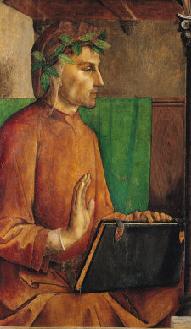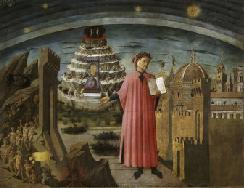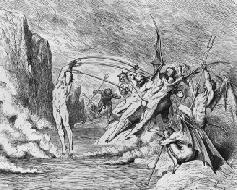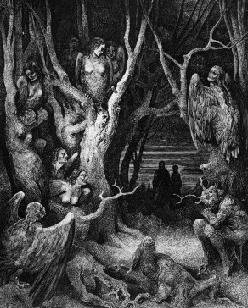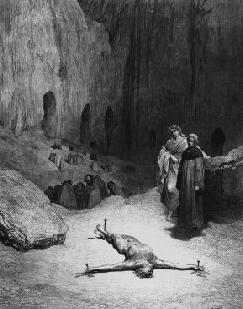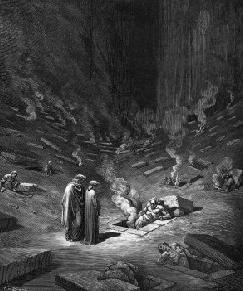
Candida Martinelli's Italophile Site

Main
Page This family-friendly site celebrates Italian culture for the enjoyment of children and
adults. Site-Overview
The full text, the most famous illustrations, an audio version, and
a show to watch on DVD that provides a wonderful introduction to
Dante's famous work, all from Amazon.com.
Europe was in the
process, sometimes the violent process, of deciding how much
influence the church should have in running matters of state.
Today's Europe is secular, meaning that church and state
are separate, and rarely interfere with each other, and refrain from
dictating to each other. Secular states allow for greater
religious diversity and greater personal liberty than religious
states. But that was anything but the case during Dante's
time. Dante believed in God, and in secularism. He was
persecuted for his secular beliefs by banishment from his
beloved nation-state of Florence. So Dante, in exile,
sought solace in his religious beliefs: he wrote The
Divine Comedy.
Imagine you had been slighted by many of your friends,
defeated by your enemies, and was made victim to the machinations of
corrupt leaders and civil servants. Now imagine, what your
revenge might be. Dante was not a violent man, so his revenge was not bloody.
Dante was a writer, so his revenge took the form of a book,
The Divine Comedy, in verse that would both entertain and
educate readers, and malign those responsible for his situation. If Dante's book were solely rants against his enemies, it would
never have stood the test of time. In fact, the parts of
The Divine Comedy in which he mentions by name the leaders and
rich of his day, wallowing in Hell or Purgatory, are least
accessible to us today. We don't know who these people are, so
we miss the joke. (However, what a wonderful revenge, to make
these people, for eternity, examples of Hell's and Purgatory's
torments!)
But by making The Divine Comedy a detailed description
of Hell, Purgatory and Paradise, and detailing the sins and
qualities that land us in each of these zones of the
netherworld, Dante ensured that his tale would appeal to readers
forever. It's immensely fun, and delightfully satisfying, to read an
imaginative account of where your own enemies might end up, and
how they'll suffer eternal damnation for what they've done to you
during your lifetime. In fact, the most entertaining
section of The Divine Comedy is Hell! Dante encourages us to behave better in life, just in case
his imaginings are anywhere near the truth of what becomes of us
after death. Just like religions themselves, Dante, by
illustrating the Christian view of afterlife, gives us hope of
rewards after death for self-restraint during life. Justice
comes to all, even if a bit late, and it lasts for eternity. To top all that off, Dante accomplished another goal of his, one
that he had cherished for a long time. He strongly believed
that beautiful literature could be written in the daily language of
Florentines. So he wrote The Divine Comedy in
ordinary Italian, rather than in the preferred Latin. The
book's success did wonders for raising the respect level of the
Italian language.
Amazingly, Dante's Italian is very readable to student's of
today's Italian. It is not like the middle-English
literature written in the 1300s, or even like Shakespearean English
from the 1600s. Dante's Italian is accessible, especially when
accompanied, side-by-side, by an English translation.
So I report the text below in both English and
Italian, side-by-side. But remember, there are scholars who study The Divine
Comedy all their scholarly lives. There are books
published yearly interpreting everything from Dante's use of
numbers, names, places, stars, words, smells, sounds, light, dark,
literary figures--oh, you get the picture.
But that doesn't mean the average reader cannot enjoy The
Divine Comedy. Take my advice: kick anyone who tries
to tell you The Divine Comedy is too complex, or that you
need an accompanying explanatory book ten times the length of the
poem. If you enjoy your first read of Dante's entertaining
story, you can always consult those books later. My advice would be to start with the parts that interest you
the most. For most people, that would be Hell.
Those wonderful levels of Hell Dante describes with various sinners
and their punishments that fit their crimes, are full of juicy, gory
details.
The artist Gustave Dore created dark illustrations of
those gory details for an 1885 edition of The Divine Comedy.
I've put many of those designs on this page for your enjoyment.
For other illustrations, from other editions of the book, check:
If you want an overview of the story, characters, themes, Dante's
life, etc., visit the free and invaluable Novel Guide Summary.
If you want to see two translations to English, side-by-side,
visit this Columbia
University site. For a sampling of the scholar's Dante, visit
this site
and select 'Dante Studies' from the menu. To learn more about the early publications of the book, visit
Renaissance Dante in
Print. They have a fascinating collection of
title pages from editions from 1507 to 1716, showing the
progression of 'The Comedy by the Divine Poet Dante Aligheri' to
'The Dante' or just 'Dante' to what we use today 'The Divine Comedy
by Dante'. Here is a link to a list of
Project Gutenberg's works by Dante, including various editions of
The Divine Comedy, all available as free e-books, in various
formats, for immediate download

Dante
Aligheri and his Divine Creation: The Divine Comedy (La Commedia)
![]()
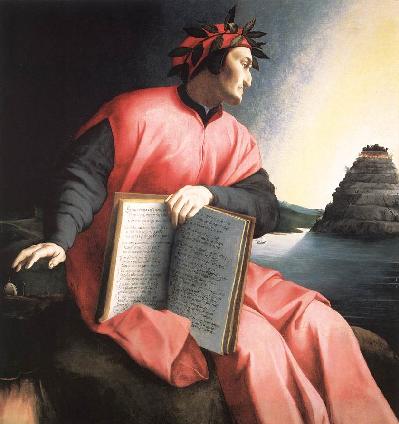


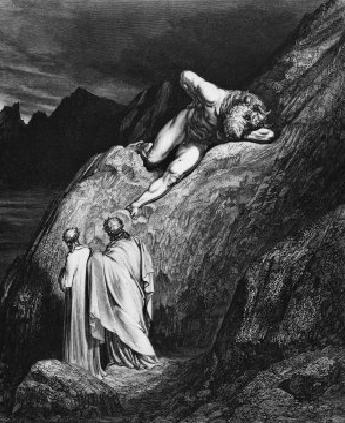
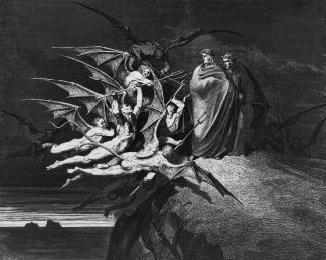

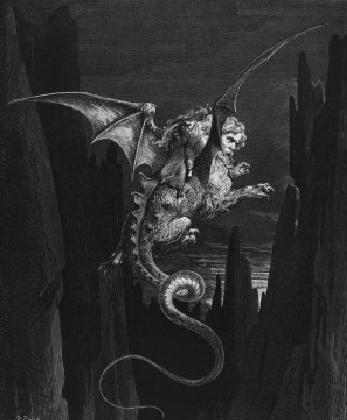
Dante Aligheri (b.1265 - d.1321), Florence, Italy's most
famous son, lived during turbulent times.
